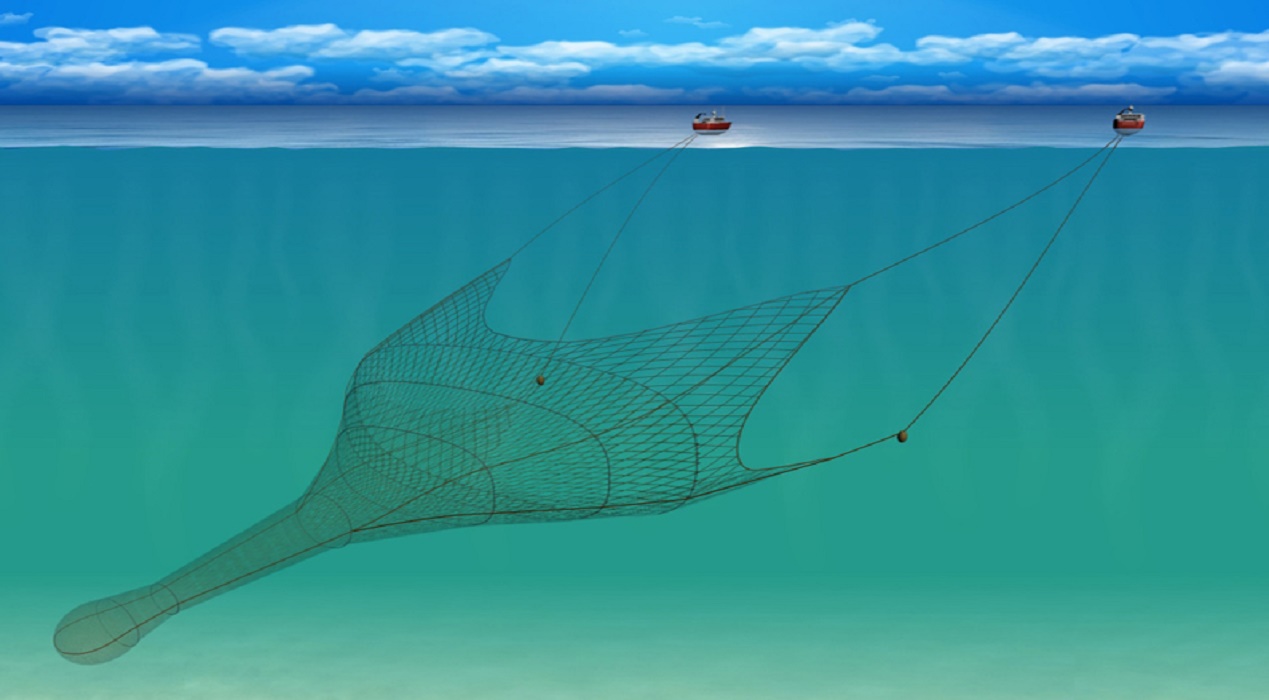Within the strategic community a less-spoken issue when it comes to China is its role in global fishing. Threat from China is often discussed in terms of its territorial aggression, military, its state-owned enterprises, its technology, hybrid warfare and so on. But attention needs to be paid to its non-military activities at the sea as well. Chinese fishing activities merit attention from perspective of comprehensive security. An apparent benign, commercial activity like fishing has become a global security issue due to China. If neglected, this would put food security into jeopardy, and it would devastate the marine ecology even further. United Nation’s Sustainable Goals number 14 calls for ‘Conserve and sustainably use the oceans, seas and marine resources for sustainable development’.
Chinese commercial behaviour at sea is nothing short of rogue. The problems one generally associates with ‘China problem’- lack of transparency, aggression, refusal to comply by extant rules; are also seen when it comes to marine fisheries. Chinese fishing vessels are becoming a common site in the Bay of Bengal and in the larger Indian Ocean region, which is why our attention is needed on this issue.
As per the latest report from Food and Agricultural Organisation of the United Nations China is the largest fish exporter in the world today1. Yet there is no transparency about fishery management in China. According to The Illegal, Unreported, Unregulated (IUU) Fishing Index 2019, China has ranked the worst for IUU fishing2. China over-exploited its own territory, ran out of fish and hence has been venturing farther across the globe in search of seafood. China today has the largest fishing fleet in the world. Five years ago, it was estimated that China has about 200,000 fishing vessels3. But within this number, one needs to specifically look at China’s distant-fleet. (DWF). As per a latest estimate based on satellite data, China’s DWF has close to 17,000 fishing vessels4 (registered in China) and about 1000 registered under flags of convenience5. To compare, the European Union DWF had 289 vessels in 2014 and the US was reported to have 225 large Distant Water Fishing (DWF) vessels. China’s scale in global fishing is simply unmatched.
With this scale it is not surprising to know that China accounts for the biggest fish catch in the world. In 2015, for example, China produced 17.6 million tonnes of fish from capture and 47.6 million tonnes from aquaculture6. For reference, the global capture fish production was 96.4 million tonnes in 2018. The same year, global aquaculture production was 114.5 million tonnes.7 China’s capture accounts for nearly 20 per cent of global catch8. On the face of it, this seems normal and one would wonder why the alarm. But by now we know that everything concerning China- be its infrastructure or developmental assistance comes with a catch. So is the case here. Chinese fishing vessels, specifically its DWF have become infamous for fishing into traditional fishing areas of coastal states as well as in their exclusive economic zone (EEZ). There are three distinct cases where the adverse impact of Chinese DWF is well documented- North Korea, Ecuador and, Sierra Leone.
In North Korea, Chinese fishing vessels have been fishing illegally. Illegally because in 2017 there was a preventive order on fishing in Korean EEZ, as part of general sanctions on North Korea. China has been flouting this order which has grave consequences on North Korean fisherman. Stories of ‘ghost ships of North Korea’ were widely covered in the media. These were local fishing boats that drifted ashore with dead fishermen. This tragedy happened because North Korean fishermen had to sail deeper into the sea for a catch, and neither they nor their boats were equipped for deeper and farther venturing. But why did the fishermen have to embark on such a risky sail anyway? This was because their traditional fishing grounds were completely depleted of seafood, thanks to the illegal Chinese fishing vessels.
It has been reported that the squid population in North Korean waters has depleted by 80 percent due to Chinese fishing activity. Chinese use extremely exploitative techniques; the fishing boats have arrays of very bright lights that attracts squids. Chinese fishermen catch young squids before it can propagate, causing irreversible decline to squid population locally. Local fishermen are thus forcedfarther into the sea and more often, never to return alive. In 2014, 65 ‘ghost ships’ were reported on North Korean coasts; in 2018 it was 225 and in 2019 the number was 1589
Similar situation is seen in waters off Sierra Leone which boasts of one of the richest fishing fields in Africa. Chinese DWF have reached as far as the western coast of Africa. Here as well Chinese fishing activity has driven locals out on employment, exacerbating poverty. It is reported that Chinese take away most of the prized catch, leaving only small sized-fish for the local fishermen; which barely fetches any money10. Just like in North Korean waters, Chinese fishermen use exploitative methods- in this case ‘pair trawlers’- where two trawlers sail parallel, a wide net between which enhances catch multi-fold11. This is a horrific fishing practice that, experts have stated; to have caused irreversible damage to marine ecology. Trawlers are anyway infamous for being unsustainable since it gathers a lot of by-catch. Imagine a free pass to pair trawling going on for longer periods! Pair trawling practice is illegal in Sierra Leone but continues unfettered.
Chinese fishing activities in the Galápagos islands off Ecuador is another horrifying story. Recently the Ecuador navy discovered a fleet of 340 fishing vessels very close to the Galápagos marine reserve. Galápagos islands is a rich biodiversity zone and it is known for giant tortoise and iguanas. In 1978 it was declared at a UNESCO world heritage site. In 2017, a Chinese fishing vessel was intercepted and it was found that it had captured 300 tonnes ofcatch,-which had 6000 frozen sharks and also included endangered species like Hammerhead Shark and White Head Shark12. Recently, Mike Pompeo criticised Chinese activities13:
“The People’s Republic of China subsidizes the world’s largest commercial fishing fleet, which routinely violates the sovereign rights and jurisdiction of coastal states, fishes without permission, and overfishes licensing agreements. Given this unfortunate record of illegal, unreported, and unregulated fishing, rule-breaking, and willful environmental degradation, it is more important than ever that the international community stands together for the rule of law and insists on better environmental stewardship from Beijing.”
If lawfully conducted, foreign fishing vessels in EEZ of a coastal state is a great source of revenue. In Sierra Leone’s case, it gets less than ten per cent of revenue from foreign fishing vessels. China takes advantage of weak governance in foreign countries to influence it and makes rules to its advantage. Another way Chinese fishing is undertaken is through flags of convenience.
What enables Chinese DWF in the first place? The primary reason is that Chinese DWF is heavily subsidised. Distant- water fishing is unviable without subsidies. As mentioned earlier, Chinese over-fished waters around it, which exceeded its annual catch allowance since 199414, hence the need to exploit elsewhere. Seafood is the major source of protein for Chinese population. Chinese also practice aquaculture, so the ‘by-catch’ or non-consumable seafood is used to make food for cultured fisheries. A more fundamental issue emerges out of China’s political system, where in order to be promoted, an official has to ‘show’ that production has increased in his/ her department on a yearly basis15.
When one studies Chinese IUU fishing, a pattern emerges. Operationally, the fishing vessels operate in massive numbers. Pair trawling is common. Several times, the vessels turn of the automatic-identification system (AIS) to evade detection. There exists a logistical chain along with fishing vessels that provides, which ensures that fishing is nearly continuous. It is reported that fishing vessels often trans-ship the catch in international waters, thereby not visiting the coastal state port so as to avoid any inspection or accountability. This transferring practice is forbidden as per international law. It takes advantage of weak governance in coastal states. There are clear rules for foreign vessel fishing of EEZ, such as carrying an observer on board. These rules are hardly followed. Human rights violations are also reported on board.
In terms of its impact, Chinese IUU fishing has led to depletion of fishing stock, caused unemployment, exacerbated poverty and misery of the local population. Experts warn that Chinese activities promote monoculture which is ecologically devastating. It has devastated marine ecology to a point of no return. If, China really meant its oft-used ‘win-win’ strategy, it would have duly paid the requisite fees by fulfilling its user state duties to the coastal state, would have ensured sustainable practices. As a country that wishes to be the global superpower, it would have ensured security of marine ecology and well-being of local people. But China is essentially a modern power with post-modern façade. Being a global superpower comes with global responsibilities, where China’s commitment is questionable.
References:
- The State of World Fisheries and Aquaculture 2020. Food and Agricultural Organisation of the United Nations. Rome. http://www.fao.org/documents/card/en/c/ca9229en
- Macfadyen, G., Hosch, G., Kaysser, N. and Tagziria, L., 2019. The IUU Fishing Index, 2019. Poseidon Aquatic Resource Management Limited and the Global Initiative Against Transnational Organized Crime. Available at https://globalinitiative.net/wp-content/uploads/2019/02/IUU-Fishing-Index-Report-web-version.pdf
- Zhang Hongzhou, (2015), ‘China’s Fishing Industry: Current Status, Government Policies And Future Prospects’, China As A Maritime Power, CAN Conference Facility, Virginia. Available at https://www.cna.org/cna_files/pdf/china-fishing-industry.pdf
- Gutiérrez, Milan et al; China’s Distant water Fishing Fleet- Scale, Impact and Governance, Overseas Development Institute, London. June 2020. Pp 12. Available at https://www.odi.org/sites/odi.org.uk/files/resource-documents/chinesedistantwaterfishing_web_1.pdf
- Collyns, Dan. "'They just pull up everything!' Chinese fleet raises fears for Galápagos sea life". The Guardian. 6 August 2020.
- Country Brief- China. Food and Agriculture Organisation of the United Nations. December 2017.
- Op.cit.
- Op.Cit. pp 12
- Urbina, Ian, (2020), ‘The Deadly Secret of China’s Invisible Armada’, NBC Newshttps://www.nbcnews.com/specials/china-illegal-fishing-fleet/
- Is China's fishing fleet taking all of West Africa's fish? - BBC News 26 March 2019.
https://www.youtube.com/watch?v=nUClXFF2PKs - Ghost Boats': How A Secret Chinese Fishing Fleet Is Killing North Korean Fishermen | NBC News 22 July 2020.
https://www.youtube.com/watch?v=8PZzxF4hwVI - Op.Cit.
- Press Statement- ‘On China’s Predatory Fishing Practices in the Galapagos’, Department of State, 2 August 2020. URL: https://www.state.gov/on-chinas-predatory-fishing-practices-in-the-galapagos/
- Baxter, Tom (2017) ‘ China has a big overfishing problem’, GreenPeace URL:https://www.greenpeace.org/eastasia/blog/1370/china-has-a-big-overfishing-problem/
- Reville, William, (2002), Something fishy about the figures, The Irish Times. 14 March 2020 URLhttp://www.seaaroundus.org/newspapers/2002/IrishTimes_14Mar02.pdf (Accessed 22 Sep. 20)
(The paper is the author’s individual scholastic articulation. The author certifies that the article/paper is original in content, unpublished and it has not been submitted for publication/web upload elsewhere, and that the facts and figures quoted are duly referenced, as needed, and are believed to be correct). (The paper does not necessarily represent the organisational stance... More >>
Image Source: https://www.cornwallgoodseafoodguide.org.uk/documents/images/22-Pelagic-Pair-Trawling-800.jpg











Post new comment